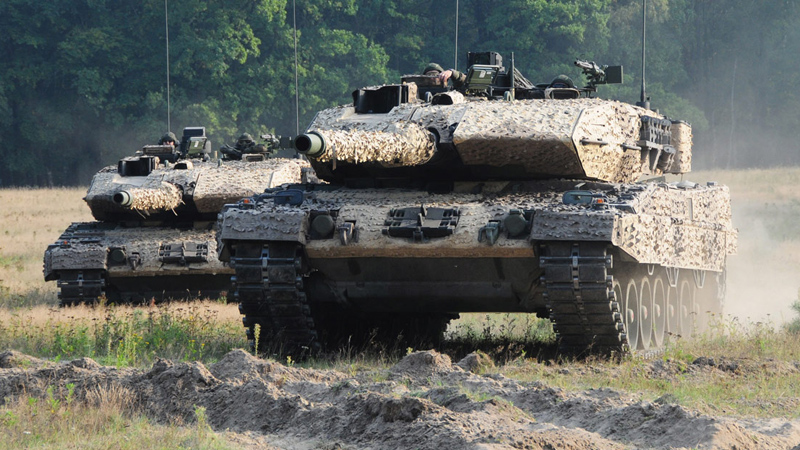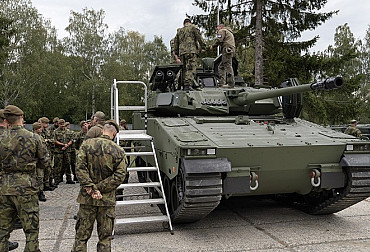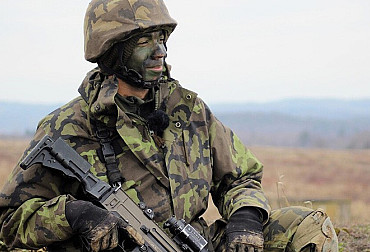Leopard 2 will bring the 73rd Tank Battalion the long-awaited capabilities at the level expected by our allies
On Wednesday, 18 May 2022, the agenda of the Government meeting includes information on the procurement "T-72M4 CZ - repair and maintenance". This is a topic that in a way is closely related to the information from last week, when the Minister of Defence Jana Černochová (ODS) stated on Czech Television's programme "Events and Commentaries" that the Government is negotiating with Germany on the compensation of Czech heavy combat equipment provided to Ukraine. This will involve the acquisition of Leopard main battle tanks. And, of course, it will be the Leopard 2 or 2A4 version and higher, despite various senseless musings about the original Leopard 1s that appeared in the press soon after the interview. It was the 2A4 version that the Secretary of State for Defence was no doubt referring to when she spoke at the time of eight versions and a version 'somewhere in the middle' - the delivery of Leopard 1 might be of interest to the Military History Institute. From the point of view of modernising the armament of the 7th Brigade, they are out of the question. At the same time as the project of introducing Leopards 2, the questions of their number, and also the fate of the existing T-72M4 CZ tanks are being raised.
 Picture: The Leopard 2A7+ tanks are among the world's best in every respect and far surpass anything Russia can theoretically put up against the West (illustration photo) | KMW
Picture: The Leopard 2A7+ tanks are among the world's best in every respect and far surpass anything Russia can theoretically put up against the West (illustration photo) | KMW
First of all, it should be added that even in the case of Leopard 2 tanks we are talking about two different versions. In the form of a gift, i.e. compensation for the T-72M tanks provided to Ukraine from the Czech Army's warehouses, the Czech Army should receive twenty Leopards of the 2A4 version. It is an extended variant of the tank from the late 1980s and early 1990s. These tanks are now available in Poland, Austria and now also in Hungary. It is following the example of Hungary, unlike Poland, that the Czech Republic should go on to purchase probably up to four dozen more modern Leopards, ideally at least the 2A7 version from 2017.
Leopard 2A4 tanks can theoretically be delivered to the soldiers of the 73rd battalion very quickly and retraining of the crews and training of the soldiers can immediately follow, which will then guarantee a smoother transition of the battalion to the current 2A7+ variant, whether in Czech conditions it should be an upgrade of the acquired 2A6, 2A7, or the latest version purchased directly from Germany, including the latest applied technologies in the state in which the Leopards 2A7V come to the Bundeswehr units or as 2A7HU to Hungary.
The 7+ standard tanks are among the world's best in every respect and far surpass anything Russia can theoretically put up against the West (not much is known about the deployability of Armata tanks and their actual capabilities). They differ from earlier versions in having a powerful 120 mm calibre gun with the barrel lenght of 55 calibres, more durable passive and more effective active protection, a more powerful auxiliary power unit and the latest electronic instruments, including thermal imaging, which the driver has in addition to the commander and gunner.
The Czech industry will certainly also have a high involvement in the modernisation and/or direct production of the Czech 2A7 tanks, which will then play a key role in the maintenance of the tanks during their life cycle. This is with the advantages provided by the Leopard tank user-country grouping, the so-called LeoBen, and with the undeniable advantage that the tank manufacturer, Krauss-Maffei Wegmann, is based in nearby Munich.
The arrival of the 2A4 Leopards appears at first sight to be a very advantageous and appropriate solution, unlike the problematic and lengthy modernisation (or technical evaluation) of the existing T-72M4 CZ tanks by the state enterprise VOP CZ. The combat value of the 2A4 Leopards is obviously lower in most parameters compared to the Czech modernised T-72M4 CZ tanks, but they will be fully available, while the Czech tanks are gradually undergoing repairs and modernisation until 2026, and thus only a fraction of them are available to the unit. Incidentally, Hungary has taken a similar approach to the modernisation of its tank force, where the first of the twelve Leopard 2A4s purchased have also already been delivered and training of crews for future rearmament to the 2A7HU variant has begun (Hungary will have 44 of these in total).
If the Czech Republic takes advantage of the offer of 20 Leopard 2A4s, it will have significantly more of these older vehicles than Hungary. This will allow for faster and more intensive retraining of crews. Unlike the T-72, the Leopard 2 does not have automatic charging, but a four-man crew including a charger. Discussions about the advantages of either approach are endless. To simplify the argument for manual reloading, it is that the first three shots, often decisive in combat, can be fired more quickly by a tank with a four-man crew than by a tank with automatic, and therefore constant, reloading. At the same time, it is not only in Ukraine that we are witnessing a pernicious feature of tanks of Soviet design, which, due to the inappropriate way of storing ammunition, tend to explode when hit, with fatal consequences for the crew. On the other hand, and we will conclude this digression, it is true that the MGCS tank under development provides for automatic reloading.
The higher number of Leopard 2A4 tanks would also indicate that they could be used not only for training but also as armament for an Active Reserve tank company. Another forty Leopard 2A7+ tanks, which differ from the 2A4 at first glance by their arrow-shaped frontal turret armour (and longer barrel), will ensure the stable deployability of three professional companies - as opposed to the current table number of 30 T-72M4 CZs, the reserves will also be available. Naturally, the differences between the 2A4 and 2A7+ are many - these include a different fire control system, and so the transition to modern tanks will not be without complications. On the other hand, even 2A4 tanks are upgradable to the 2A7 standard in the future, and dozens of Bundeswehr tanks have already gone through this process. It will certainly be useful to learn from the Polish problems in such a modernisation, which are complicated by, among other things, the licensing restrictions imposed by the relationship between the KMW manufacturer and the modernisation contractor Rheinmetall.
When the Leopard 2A4 tanks are mentioned, discussions immediately bring to mind the losses of Turkish tanks in Syria. In all, a dozen tanks were supposed to have been disabled by Fagot or Konkurs missiles, hit by mines or damaged by improvised explosive devices. It should be added here that this was an older variant of the tank and that the issue of the training and experience of the crews and the circumstances and conditions of deployment of the tanks always play a role. The weight of the Leopard tanks, approaching 70 tonnes, and the consequent limitations on movement over Czech bridges are also widely mentioned. Certainly, this needs to be taken into account, but the weight of these vehicles is not an end in itself and brings durability and capabilities that light tanks of Soviet design do not and cannot have. Recall also that every one of our neighboring and allied countries has Leopard 2 tanks except Slovakia.
As such, the tanks have proven their effectiveness in all conflicts. On a modern battlefield oversaturated with effective anti-tank weapons, there are of course casualties, but the combination of speed, durability and powerful firepower has and will continue to have its effect and its use, especially with the use of modern technology and through integration with other systems. The Leopard 2 tanks are the only modern main battle tanks in production in Western Europe today, and as such are the logical choice for the rearmament of the 73rd Battalion. In their form, the Army of the Czech Republic will acquire weapons designed not for expeditionary missions, but for the defence of the territory of the Czech Republic and NATO allies. Last but not least, the inclusion of Leopard 2 tanks in the armament will provide experience and capabilities for the Czech defence industry, which it will then be able to further develop in the development and operation of the next generation of tanks.
As a footnote, if Poland, with its long-standing significant investment in defence, can afford to operate four different main battle tank platforms in the form of PT-91, Leopard 2PL, M1A2 Abrams and even Challenger 2 tanks, the Czech Republic should rationally rely on just one. As a result of the above, along with the takeover of the Leopard 2 tanks, there should then be a use for the remaining stored T-72Ms as well as the upgraded T-72M4 CZ. The question is whether it makes sense to continue with the questionable project of technical evaluation of these tanks, which was intended to extend their service life until 2030, when the retraining and training for Leopard 2 should start very soon.





















